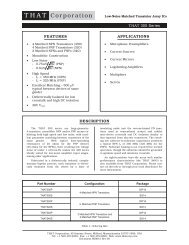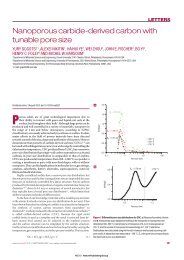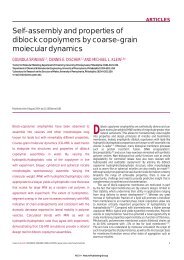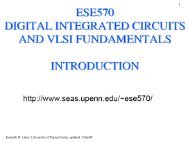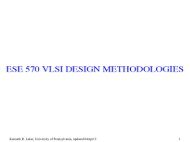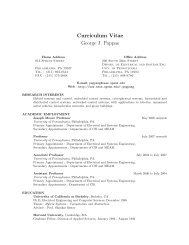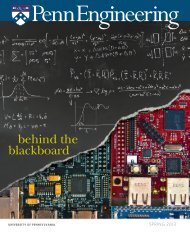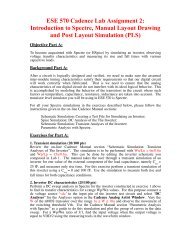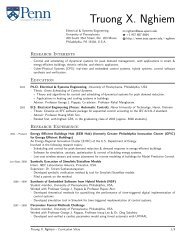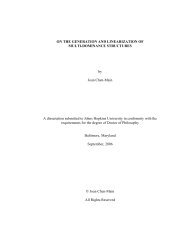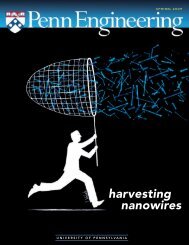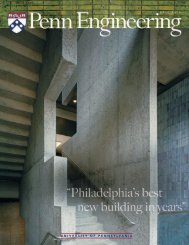1 EXECUTING THE CBE 459 DESIGN ... - Penn Engineering
1 EXECUTING THE CBE 459 DESIGN ... - Penn Engineering
1 EXECUTING THE CBE 459 DESIGN ... - Penn Engineering
You also want an ePaper? Increase the reach of your titles
YUMPU automatically turns print PDFs into web optimized ePapers that Google loves.
<strong>EXECUTING</strong> <strong>THE</strong> <strong>CBE</strong> <strong>459</strong> <strong>DESIGN</strong> PROJECT<br />
In an effort to help you organize the work on your design projects, several<br />
recommendations have been prepared which, hopefully, you will find beneficial:<br />
(1) Keep all of the <strong>CBE</strong> 400 materials in a looseleaf binder for easy access.<br />
(2) Prepare a looseleaf binder to contain materials relating to your design, including:<br />
a. Important references<br />
b. Design calculations<br />
c. Computer programs and results<br />
Bring the binder to your Tuesday design meetings.<br />
(3) For the first design meeting in January, be prepared to present your project charter in<br />
writing, as described in Section 2.2 of SSLW. Also, show your initial work on an<br />
innovation map for your product design (see Section 1.3, SSLW). In addition, show the<br />
initial results of your market and competitive analyses and indicate customer<br />
requirements (see Section 2.4, SSLW).<br />
Then, when a process is being designed, discuss your findings, thus far, concerning:<br />
a. A survey of the methods used in manufacturing the product, giving the raw<br />
materials, the principal chemical reactions, byproducts, and intermediates.<br />
b. A discussion of the choice of the production level and plant location.<br />
c. Create a block diagram showing the principal steps for the process anticipated to<br />
be the most promising (SSLW – p102). When possible, prepare promising<br />
process flow diagrams (SSLW – pp102-104)<br />
c. Reaction kinetics and thermophysical property data (Section 4.2 - SSLW)<br />
d. Economics, toxicity, and safety data (Sections 1.4, 1.5, and 4.2 - SSLW)<br />
Where you are uncertain or have questions, seek the advice of your faculty advisor and<br />
industrial consultants.<br />
These materials should be updated and presented every Tuesday, with one copy provided<br />
for your faculty advisor, Professor Fabiano, and the industrial consultant(s) who will be<br />
meeting with you.<br />
(4) Learn to use the Towne and Chemistry Libraries effectively. To help, our librarians,<br />
Douglas McGee and Judith Currano (Chemistry), have prepared a discussion of the<br />
special features of the Towne Library, use of the important indices, computerized<br />
databases, and facilities for interlibrary loans. Plan on attending their talk from 5:00-6:30<br />
p.m. on Wednesday, January 13 (room to be announced). See also Literature Survey in<br />
Section 1.3 (SSLW – pp10-12).<br />
1
(5) As your design evolves, individual team members should assume responsibility for<br />
aspects of the work. It is important that your group meet from time-to-time during the<br />
week to examine each other’s work and coordinate the next steps. See Preparation of the<br />
Written Report in Section 26.1 (SSLW – 687-689).<br />
(6) At Tuesday meetings, each student in the group should be prepared to discuss aspects of<br />
the work for which he or she is responsible. Use the meetings to discuss results and seek<br />
advice. Participation here will influence your grade.<br />
(7) Between Tuesday design meetings, you can seek help from your advisor, other faculty<br />
with specific expertise, the industrial consultants, local industry, etc. Professor Fabiano<br />
will be available for sessions by appointment on Fridays and selected evenings by<br />
appointment (see Meghan Godfrey in the <strong>CBE</strong> Office.) Our industrial consultants all<br />
have busy schedules. Please contact them only after exhausting other avenues for help.<br />
When contacting persons in industry, be sure they understand that your questions concern<br />
your senior design project.<br />
(8) Your preliminary designs should be completed by the end of January. For a process, plan<br />
to submit a preliminary material balance and a computer-drawn block flow diagram by<br />
the first week of February. For a product, focus on the critical-to-quality (CTQ)<br />
variables, the superior product concept, a competitive (patent) analysis, and other<br />
important considerations. These materials will be graded by Professor Fabiano.<br />
(9) Most of the process synthesis work should be completed by the last week of February.<br />
Plan to submit the material and energy balances for the most promising flowsheet(s), that<br />
is, base-case designs, together with a computer-drawn process flow diagram. See Flow<br />
Diagrams in Section 4.5 (pp102-104). These materials will be graded by Professor<br />
Fabiano.<br />
(10) Much of the detailed design of your new product and/or the process units for your<br />
manufacturing plant should be completed by the last week in March. Plan to submit the<br />
detailed design for your product and/or one key process unit. These materials will be<br />
graded by Professor Fabiano.<br />
(11) You will complete two survey questionnaires during the semester in which each design<br />
team member will be asked to assess the percentage effort on the project by all team<br />
members including himself/herself.<br />
(12) Feel free to use Aspen Tech's Aspen <strong>Engineering</strong> Suite (including ASPEN PLUS, SPLIT,<br />
ASPEN PLUS DYNAMICS, ASPEN BATCH PROCESS DEVELOPER (formerly<br />
BATCH PLUS), and ASPEN PROCESS ECONOMIC ANALYZER (formerly Aspen<br />
IPE), SUPERPRO <strong>DESIGN</strong>ER, the Nickisch Economics Spreadsheet (Profitability<br />
Analysis 2.0.xls), VISIO Technical Plus, MATLAB, and GAMS. These programs can be<br />
accessed from the PC's in the Towne computer labs. Use of the computer is optional<br />
throughout the course.<br />
(13) Your written design report is due on Tuesday, April 7. It should follow the format in<br />
Chapter 26 (Written Reports and Oral Presentations – SSLW). The report will be<br />
2
eviewed by your advisor and returned to you with comments before Friday, April 9.<br />
You will make revisions and submit your revised written report on Tuesday, April 13.<br />
Note that a lecture has been scheduled on Tuesday, February 16, from 6:00-7:00 p.m., to<br />
provide advice in the preparation of your design report. All students should plan to<br />
attend. Also, the design reports will be bound for storage in the Towne Library.<br />
(14) Oral design presentations will be on Tuesday, April 20. Each group will be allotted 35<br />
min (30 min presentation, 5 min questions). We will have an All-day Technical<br />
Meeting involving students, faculty and consultants. A luncheon will be held. The<br />
Senior Class Picture will be taken just prior to the luncheon.<br />
(15) As an option, each design group may prepare a poster, summarizing the highlights of its<br />
design, for display outside of the Chemical and Biomolecular <strong>Engineering</strong> Office. The<br />
posters must be completed by Friday, April 30, and deposited in the Chemical and<br />
Biomolecular <strong>Engineering</strong> Office.<br />
(16) The winners of the Melvin C. Molstad Prize, for the most outstanding design, will be<br />
honored during Commencement Exercises.<br />
(17) The three best designs will compete in the <strong>Engineering</strong> Alumni Board Competition on<br />
Friday, April 30. The three groups will be notified by Friday, April 23. Each group will<br />
be allotted 15 min (12 min presentation, 3 min questions).<br />
This year's projects are very promising and, hopefully, will lead to novel and profitable<br />
designs. Good Luck!<br />
3



